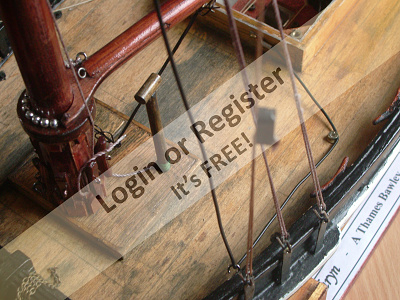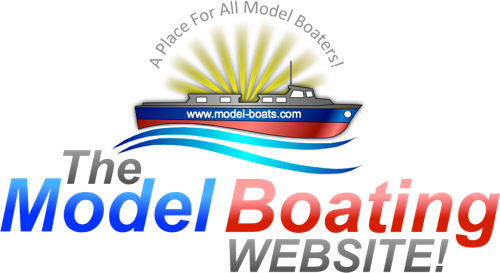Join Us On Social Media!
Kathryn, a Thames Bawley - 9
1 Post · 1 Follower · 14 Photos · 13 Likes
Began 4 months ago by
Follow This Thread
Not currently following
> Click to follow
> Click to follow
Latest Post 4 months ago by
| Most recent posts shown first (Show Oldest First) | (Print Booklet) |
📝 Kathryn, a Thames Bawley - 9
4 months ago by 🇬🇧 flaxbybuck ( Captain)
Captain)
 Captain)
Captain)✧ 45 Views · 13 Likes · 1 Comment
Flag
💬 Add Comment
All about the masts, boom, gaff, sails and standing rigging. The standing rigging are those parts of the rigging such as shrouds, stays etc that may be set up permanently.
Having prepared the masts and spars the next job was to assemble them, add the necessary fittings and fixtures and then to add the standing rigging.
Photos 1,2 and 3 show the mast foot set into the cabin roof; the cabin chimney; the boom and gooseneck with parrel line and beads, and the elastic kicking strap. Also, the black wire seen crossing the deck from the hatch and heading up the mast is the aerial wire for a 27MHz receiver. The gooseneck (or jaws) is made from ply which is slotted and glued into the boom. The parrel line and beads (chrome was not the finish I really wanted) hold the boom onto the mast whilst allowing it to move freely. The gaff is arranged in the same way but is finished off at an angle where it meets the mast. (photos 5,6 and 7)
Photos 4 and 9 show the chain plates and shrouds. The cord chosen for the shrouds is nylon. Nylon cord stretches and this enables tension to be exerted by use of bowsies. Should non-stretch cord have been used then bottle screws would be needed to tension the shrouds, and this is a much trickier job to get right than using bowsies on a stretchy cord. In addition, bottle screws are many times more expensive than home made bowsies. Bowsies for the shrouds were made from black 4 x 5mm strip nylon. Smaller bowsies of clear perspex are used for outhauls and uphauls which are under much less tension.
Photos 5, 6 and 7 also show the arrangement where the topmast is supported at the head of the mainmast.
Photos 8, 11, 12 and 13 show the arrangements used on the bowsprit, the boom, top of the topmast, and peak of the gaff. There are three sets of shrouds, the foremost passing through the spreader and on to the top of the topmast. The other two sets are attached to the top of the mainmast.
In photo 14 I have shown the various screw eyes used. Mostly I have used the 10 x 5 size, but where there is little stress or tension I have used the smaller sizes. In all cases I drill a 0.5mm pilot hole first. There might appear to be a lot of screw eyes in some of the spars, but each one has a purpose.
Lastly, for the eagle eyed amongst you, photo 10 shows two cleats attached to the port gunwhale used for tying off jib halyards.














Having prepared the masts and spars the next job was to assemble them, add the necessary fittings and fixtures and then to add the standing rigging.
Photos 1,2 and 3 show the mast foot set into the cabin roof; the cabin chimney; the boom and gooseneck with parrel line and beads, and the elastic kicking strap. Also, the black wire seen crossing the deck from the hatch and heading up the mast is the aerial wire for a 27MHz receiver. The gooseneck (or jaws) is made from ply which is slotted and glued into the boom. The parrel line and beads (chrome was not the finish I really wanted) hold the boom onto the mast whilst allowing it to move freely. The gaff is arranged in the same way but is finished off at an angle where it meets the mast. (photos 5,6 and 7)
Photos 4 and 9 show the chain plates and shrouds. The cord chosen for the shrouds is nylon. Nylon cord stretches and this enables tension to be exerted by use of bowsies. Should non-stretch cord have been used then bottle screws would be needed to tension the shrouds, and this is a much trickier job to get right than using bowsies on a stretchy cord. In addition, bottle screws are many times more expensive than home made bowsies. Bowsies for the shrouds were made from black 4 x 5mm strip nylon. Smaller bowsies of clear perspex are used for outhauls and uphauls which are under much less tension.
Photos 5, 6 and 7 also show the arrangement where the topmast is supported at the head of the mainmast.
Photos 8, 11, 12 and 13 show the arrangements used on the bowsprit, the boom, top of the topmast, and peak of the gaff. There are three sets of shrouds, the foremost passing through the spreader and on to the top of the topmast. The other two sets are attached to the top of the mainmast.
In photo 14 I have shown the various screw eyes used. Mostly I have used the 10 x 5 size, but where there is little stress or tension I have used the smaller sizes. In all cases I drill a 0.5mm pilot hole first. There might appear to be a lot of screw eyes in some of the spars, but each one has a purpose.
Lastly, for the eagle eyed amongst you, photo 10 shows two cleats attached to the port gunwhale used for tying off jib halyards.














▲
⟩⟩
TonyAsh
Ray
BarryS
PhilH
jumpugly
DuncanP
Len1
Wolle
Peejay
Graham93
hermank
RNinMunich
AlessandroSPQR
|
💬 Re: Kathryn, a Thames Bawley - 9
4 months ago by 🇺🇸 BarryS (
 Warrant Officer) Warrant Officer)✧ 30 Views · 0 Likes
Flag
Congratulations on getting the rigging nicely done.
I love rigging but at about the half way point all my fingers turn into ten thumbs! My hands also grow into the size of a bears paw. LOL! Barry ▲
⟩⟩
No likes yet
This member will receive 1 point for every like received |





 United Kingdom
United Kingdom















